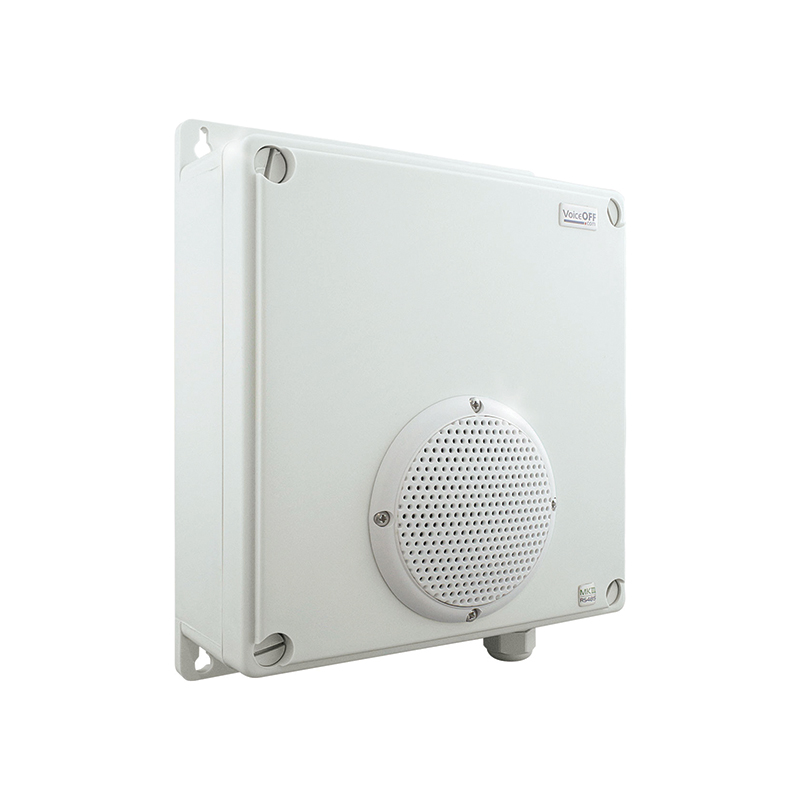 The System Q VoiceOFF Vox400 is an IP65 externally rated alarm activated audio message player to welcome, warn or inform people. It is supplied with six pre-recorded messages and has the capability to have custom MP3 messages recorded onto a micro-SD card. With remote connection, the messages can total up to 9,999. Its 10-Watt amplifier produces clear messaging and can be used to relay audio from an additional source for intrusion challenging or information.
The System Q VoiceOFF Vox400 is an IP65 externally rated alarm activated audio message player to welcome, warn or inform people. It is supplied with six pre-recorded messages and has the capability to have custom MP3 messages recorded onto a micro-SD card. With remote connection, the messages can total up to 9,999. Its 10-Watt amplifier produces clear messaging and can be used to relay audio from an additional source for intrusion challenging or information.
Getting started
The Vox400 is housed in an ABS plastic enclosure of approximately 188(w) x 236 (h) x 80 (d) mm including the speaker cover. A cable gland adds around 8mm to the height of the box.
The lid is removed by releasing 4 x plastic non-captive screws. Inside the lid is a clearly marked instruction sheet for the various connections, information on micro-SD card use and a QR code instructing you to “Watch the video here”.
The enclosure base has four ‘keyhole’ slots for wall mounting the unit. There is plenty of internal space for cable connections, these are made to a group of 19 terminals at the lower right of the pcb. Terminals are a standard size that can take a regular 3 mm terminal driver. The first 8 terminals are designated as alarm inputs 1 to 6 with a common at either end of the block. Next is a 3-way block for relay output (NO, Common, NC), then 3 for Line Out (L, C, R), 3 more for RS485 (C, Rx, Tx) and finally a 2-way for 12-volt power (-, +).
The power supply is not included but is simply a 12-volt 1.5A power supply (POW803 recommended) that can provide the unit’s maximum 200mA demand and 55mA standby.
An RCA (phono) connector at the left-hand side of the board is used for audio input, a multi-turn potentiometer at its left is used to set the trigger level for the input to override the messages. Alongside the micro-SD card slot is an RJ45 socket for the network connection. A yellow LED indicates activity.
Loudspeaker audio output is fed from a 3-way terminal block near the top of the board. This is designated L, C, R, with the speaker connected to the R channel leaving the L channel for any optional slave speaker. A couple of further multi-turn potentiometers at the bottom right of the board control the volume level for the L and R channels respectively.
A pair of function reset links are provided on the board, these are normally in their open state and can be used for IP and password resetting.
Care should be taken when refitting the lid as the seal beading can slip out of its groove and potentially compromise the environmental protection.
Operation
Once powered the unit is ready for operation. Its six alarm inputs are normally open and can be easily tested using the flying lead that is supplied connected to the first common terminal.
Six pre-recorded messages are provided on the included 128MB card. The first three of these are warning messages to deter intruders, the next two are welcome messages and the final one plays the sound of police car sirens in the distance. The warning and welcome messages are all around 6 to 10 seconds long and the siren plays for just over two minutes.
These can be replaced with your own messages, or a new micro-SD card used with the files being stored in a “SYSQ” folder on the card and the files named as 0001.mp3 to 0006.mp3 as required.
When using remote control of the unit via network or RS485 connection, the system can handle a vast range of files up to 9,999 as long as the same 4-digit file name format is used.
The unit includes two amplifiers with one driving the main speaker and the other available to drive an optional slave speaker unit, the Vox120.
Line out is available to feed an additional amplifier.
The unit has a simple webserver that allows the IP addressing, Device name and password to be changed. The password is not forced so can remain at its simple default. DHCP is not enabled by default so for use on a network you must first access it using its default IP address of 192.168.1.254. Control software in Lite and Pro versions is available to manage and provide scheduling of messages.
Read the full review in the May 2024 edition of PSi magazine

